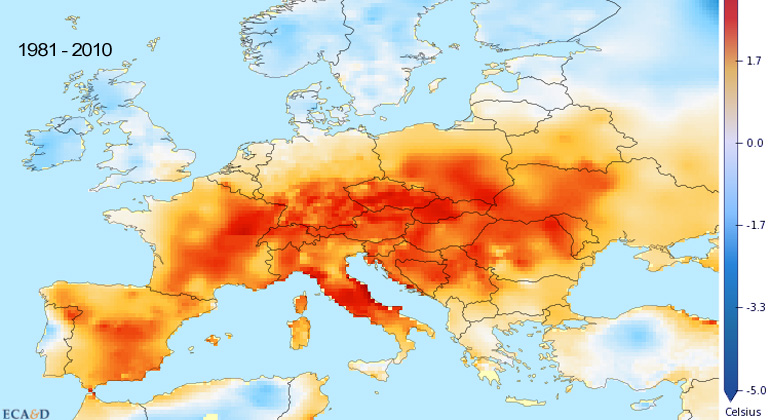2015 second hottest year on record for Europe
The year 2015 will be the second hottest on record in Europe, with mean annual temperatures just above the 2007 average and below the record set in 2014, according to an analysis by one of the World Meteorological Organization’s regional climate centres.
Much of eastern Europe was exceptionally warm, with temperatures higher than in 2014. Only in parts of Ireland were temperatures lower than the 1981-2010 long-term average, according to the Climate Indicator Bulletin from WMO’s European Regional Climate Centre node on Climate Data operated by the Royal Netherlands Meteorological Institute, KMNI.
Globally, 2015 remains on track to the hottest year on record, according to WMO’s provisional statement on the status of the climate in 2015. Final figures will be released in early 2016.
The Climate Indicator Bulletin is based on a large number of measurements and gives an overview of the 2015 temperature evolution in Europe. The mean annual temperature in 2015, as an absolute value, was 11.099° Celsius, compared to 11.234°C in 2014 and 11.079°C in 2007.
The temperature anomalies (with respect to the 1981-2010 long-term average) show large contrasts over Europe in all seasons.
“Striking are the below-average temperatures in Spain and Portugal in winter, the cooler than usual summer in northern Europe and the persistent coldness in Ireland,” said the Bulletin.
Spring was particularly warm in Spain, where mid-May saw unseasonably warm temperatures of 40°C. Conditions were exceptionally hot in Spain at the end of June, with 44°C reached in Cordoba and a new Madrid July record. This heat spread north and east bringing heat waves to central Europe. Paris saw very hot weather with about 40°C; Germany broke an all-time record for hottest day of the year and Switzerland also had its second warmest week ever (behind the 2003 value).
The Bulletin highlighted the significant year-to-year variability that exists in Europe’s climate. “While record European-wide temperature averages should not be expected for each successive year, or for every part of the European domain, the variability from year-to-year is superimposed on a long-term warming trend,” it said.
Climate Indicator Bulletins are user-driven climate information products which provide simple, effective and timely knowledge abstractions from the large amount of observation and reanalysis data. The bulletins focus on user groups in sectors such as disaster prevention, health, energy, water resources, ecosystems, forestry, agriculture, transport, tourism and biodiversity at European, national and local levels.
The European averaged temperature is based on the E-OBS data, via the WMO RA VI Regional Climate Centre – node on Climate Data.
The Climate Indicator Bulletin is available here.








